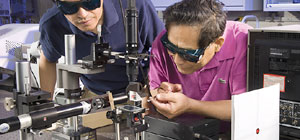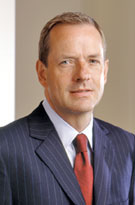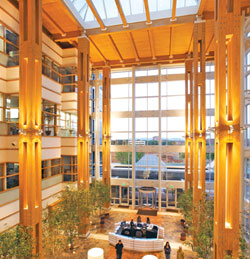

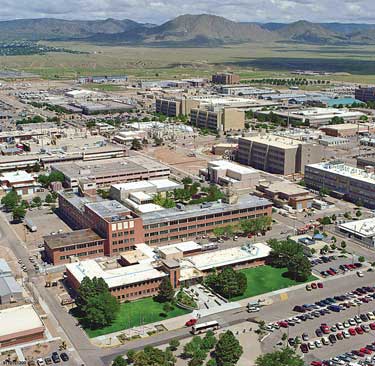

s the United States government enters the fraught territory of company ownership and “industrial policy,” it might do well to consider its own infrastructure of national facility complexes as a growth engine too. National laboratories, NASA research centers, military bases and health centers pack their own brand of economic impact. The research and science parks in proximity to those complexes are prime spots for corporations to do their part.
On the 10th anniversary of its inception, Sandia Science & Technology Park (SS&TP) was recognized by the Association of University Research Parks as its Outstanding Research Park of the Year for 2008. It was the first time the AURP had so honored a park that was not affiliated with a university. But its affiliations with Kirtland Air Force Base and with neighboring Sandia National Laboratories carried plenty of weight.
“When we started 10 years ago, Sandia knew nothing about how to start a research park,” says Jackie Kerby Moore, the park’s executive director and a career Sandia National Labs employee. In an interview conducted at the annual global conference of the International Association of Science Parks (IASP), she says coming to such gatherings helped her see that a park established with a world-class, intellectual property-generating R&D institution such as Sandia could follow the university model. It didn’t hurt that Sandia already had over 100 industry partners across the nation.
She also learned that other parks at national labs were at various stages of development, including parks near NASA Ames in California, Oak Ridge, Tenn., Richland, Wash., and Los Alamos in her own state.
Today, the 250-acre (101-hectare) SS&TP has about 40 percent of its land left to develop, and proudly counts 29
companies and more than 2,100 employees on its premises, earning an average salary of more than US$70,000. The first company to arrive, EMCORE, was hatched from the national lab across the street. Two entrepreneurs left Sandia, then saw their company acquired by a firm in New Jersey, which eventually chose to establish a major division and then its entire corporate headquarters at SS&TP. Today its payroll numbers some 500, engaged in the development of photovoltaic products for satellites and telecommunications applications. A new application about to make its debut may have national implications in the quest to grow a smart electrical grid.
“EMCORE is developing and deploying Concentrator Photovoltaics (CPV) systems for primarily grid-tied utility applications,” writes Hong Hou, one of those Sandia scientists, now EMCORE’s president and CEO, in an e-mail. “We have built and connected 175-kW CPV systems to our buildings through PNM’s (Public Service Company of New Mexico) commercial distributed generation (DG) program. We are planning to expand our DG project to 2 megawatts using the land we leased from the State Land Office. The land, which was the land fill site, is in close proximity to our facility.
Hou says the proximity and accessibility to Sandia National Labs distinguishes SS&TP from a business park. The company owes more than half its current revenue to successful technology transfers and commercializations.
“We have been working with the Lab very closely to commercialize new technologies and to get assistance for new product development and validation,” he says. “We will continue to mine the technologies developed at Sandia for future possibility of commercialization. In addition, we are working closely with other tenants of the park as we have developed more critical mass and a technology cluster.”
“We’ve worked hard to create a business community, and we track the amount of business,” says Kerby Moore of the cluster. Many of the companies have government contracts, with a number associated with space applications.
Kerby Moore says one significant difference between a park like hers and a standard industrial park is having a full-time staff that supports tenant companies in business development. “If you buy land and move into a non-research park environment, once you close the deal, everyone goes away,” she says.
Applied Technology Associates started out in 1975 as a provider of R&D services and support to the airborne laser lab. The company has since expanded its capabilities into data acquisition and data analysis systems, hardware and software systems development and advanced optical systems, including applications for spacecraft. The company’s products are all about precision sensing, motion and control.
The company has grown by 25 percent annually for the past two years, and also maintains facilities on Kirtland AFB and White Sands Missile Range in New Mexico. Today it is poised to expand its facilities at SS&TP.
“Since we moved in, a line of hardware products has expanded, so we really needed to expand our manufacturing facility,” says Anthony Tenorio, ATA’s president and CEO. “it turns out our products made it into space. Our building was really designed for people. So we needed to retrofit our building.”
The manufacturing expansion will add 24,000 sq. ft. (2,230 sq. m.) to the existing 16,000-sq.-ft. (1,486-sq.-m.) building. Tenorio says the goal is to start construction in early July and finish by May 2010. About 30 percent of the new space will be a high-bay area to accommodate spacecraft integration testing.
Tenorio, a native of the area, joined the company in 1983 after having been a civil servant at the Kirtland weapons lab. The company first came to SS&TP in 2001, when it was looking to expand from a
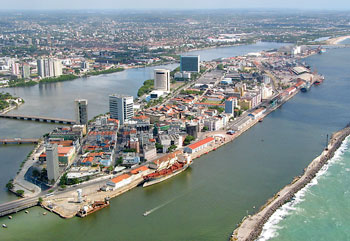
smaller building on the other side of Albuquerque.
“Prior to that, we had tried getting into the door of Sandia,” says Tenorio. “We tried many times to break in, and we had not been able to. One of the commitments [SS&TP Program Director] Jim Clinch and Jackie have given us is a lot of exposure. That was a deciding factor. We’ve always had a good portfolio of products that we knew fit into what they do, and the movement just gave us great visibility.
“Also, the location is right at the entrance to the base,” he says. “Right in this area, there are companies we’ve established relationships with. We do business with several of them now, because we’re co-located.”
Kerby Moore says the park’s prospect list is currently filled with energy and defense companies. “Interestingly enough, we’re getting a lot of inquiries, more than normal,” she says. That’s good, given the competition.
“At Sandia National Labs, the annual budget is $2.4 billion – that’s how much the Chinese government has invested in the Hong Kong Science Park,” she says. “We employ 10,000 people, and to think that a government would invest that same amount of money in a research park was astounding.”
Kerby Moore says the park has a lot of partners who are interdependent and have worked together well through leadership changes. But she says if she were starting over now, one thing she’d change is to make the park’s memorandum of understanding more formal and binding. That said, however, she and the park’s companies are looking ahead, not behind.
“In addition to running our park, I run our entrepreneurship program,” she says. “Since its inception, we’ve had 136 Sandians leave to help start companies. The program allows them to leave Sandia on entrepreneurial separation, start a company, and Sandia will promise them their job back after two years.”
Such a program might seem contrary to the conservative mindset that usually reigns at a national lab that performs weapons work and has a national security mission. But Kerby Moore says her team has worked hard to create an entrepreneurial culture.
“One hundred and thirty six have left with the understanding they could come back, and most of them have stayed out,” she says.
Site Selection Online – The magazine of Corporate Real Estate Strategy and Area Economic Development.
©2009 Conway Data, Inc. All rights reserved. SiteNet data is from many sources and not warranted to be accurate or current.
